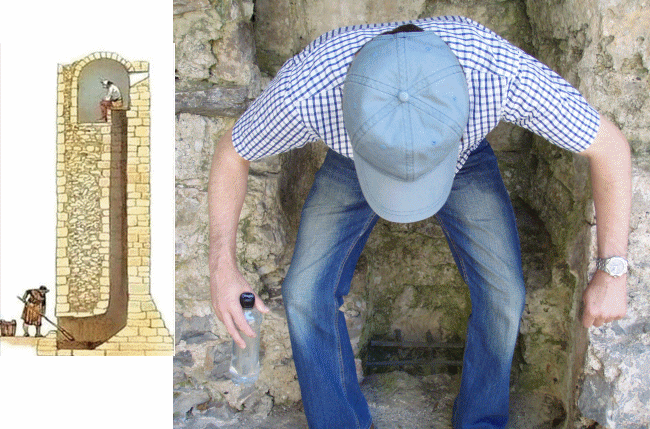The Gongfermor – Dealing with Medieval Sh*t!

(Trying a medieval “garderobe” for size at Lamphey Bishop’s Palace, purely for purposes of research you understand!)
Towards the end of the 14th Century, London with a population of around 30,000 defecating souls, had only 16 public latrines, known as “houses of easement”. However, many private latrines (privies) existed, and the local authorities had even started to regulate their placement and construction. Cess pits started to be placed in the back yard of houses or even under their cellar floors. The more sophisticated arrangements carried excrement from upper floors by means of a wooden chute, sometimes flushed by rainwater.
Just as today, the space where you did the business was often given a “polite” name. Some common ones being the ‘privy chamber’, and the ‘garderobe’. The more imaginative ones include the ‘draught’, ‘gong’, ‘siege-house’, ‘neccessarium’, and the ‘Golden Tower’.
As most cesspits were not watertight, liquid waste would drain away leaving the solids behind. Every two years or so, this solid waste would have to be removed. As you can imagine, the smell and fumes could become a problem. It wasn’t unknown for clothes to be hung nearby as the acrid vapours would kill any mites in them!
King Henry III, (who was King of England between 1216 and 1272) in a letter to one of his castle constables complained about a privy at the tower of London that smelled so bad he wanted it rebuilt before his next visit,
“Since the privy chamber…in London is situated in an undue and improper place, wherefore it smells badly, we command you on the faith and love by which you are bounden to us that you in no wise omit to cause another privy chamber to be made…in such more fitting and proper place that you may select there, even though it should cost a hundred pounds, so that it may be made before the feast of the Translation of Saint Edward, before we come thither.”
A “gongfermor” or “gong farmer” was the term used at this period to describe someone who’s job was to dig out and remove the waste. (“Gong” is derived from the Old English gang, which means “to go”). The solid waste collected had to be taken outside the city walls or town boundary and was known as nightsoil. After being dug out, the nightsoil was removed in large barrels or pipes, which were loaded onto a horse-drawn cart. The job of the gongfermor was certainly unpleasant (day in, day out, up to the knees or waist in excrement) and could be dangerous but it was also well paid.